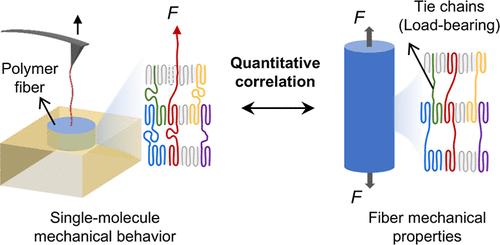Quantitative Correlation of Single-Molecule Mechanical Behavior with the Yield Stress of Polymer Fibers
IF 5.2
1区 化学
Q1 POLYMER SCIENCE
引用次数: 0
Abstract
A quantitative correlation between single-molecule and macroscopic mechanical properties is crucial for rationally improving the performance and designing polymer materials. However, it remains challenging due to the complexity of the material systems and the lack of suitable methods for characterizing single-molecule structures and mechanics in real materials. Here, we report a quantitative correlation between the single-molecule mechanics of the tie chains and the macroscopic mechanical properties of polycaprolactone and polyethylene (PE) fibers. The density and stress of tie chains were quantified by using atomic force microscopy-based single-molecule force spectroscopy (SMFS) to pull single polymer chains out of the fibers along the fiber axis. The SMFS-predicted maximum yield stress (σSMFS) was comparable to the tensile yield stress (σy) of fibers, with the utilization of tie chains (σy/σSMFS) in PE fiber reaching 96%. Moreover, this quantitative correlation was validated by the dependence of the density and utilization of tie chains on the stretching orientation. Finally, we illustrate a subnanometer-level length adjustment mechanism of tie chain, which explains the extremely high utilization of tie chain in PE fiber and further proves our quantitative correlation.

聚合物纤维屈服应力与单分子力学行为的定量关联
单分子力学性能与宏观力学性能之间的定量关联对于合理提高高分子材料的性能和设计高分子材料具有重要意义。然而,由于材料系统的复杂性和缺乏合适的方法来表征真实材料中的单分子结构和力学,这仍然具有挑战性。在这里,我们报告了领带链的单分子力学与聚己内酯和聚乙烯(PE)纤维的宏观力学性能之间的定量相关性。采用基于原子力显微镜的单分子力谱(SMFS)技术,沿纤维轴方向将单链聚合物从纤维中拉出,定量测定了链的密度和应力。smfs预测的最大屈服应力(σSMFS)与纤维的拉伸屈服应力(σy)相当,其中领带链在PE纤维中的利用率(σy/σSMFS)达到96%。此外,这种定量相关性还通过领带链的密度和利用对拉伸方向的依赖得到了验证。最后,我们阐述了一种亚纳米级别的领带链长度调节机制,这解释了领带链在PE纤维中极高的利用率,并进一步证明了我们的定量相关性。
本文章由计算机程序翻译,如有差异,请以英文原文为准。
求助全文
约1分钟内获得全文
求助全文
来源期刊

Macromolecules
工程技术-高分子科学
CiteScore
9.30
自引率
16.40%
发文量
942
审稿时长
2 months
期刊介绍:
Macromolecules publishes original, fundamental, and impactful research on all aspects of polymer science. Topics of interest include synthesis (e.g., controlled polymerizations, polymerization catalysis, post polymerization modification, new monomer structures and polymer architectures, and polymerization mechanisms/kinetics analysis); phase behavior, thermodynamics, dynamic, and ordering/disordering phenomena (e.g., self-assembly, gelation, crystallization, solution/melt/solid-state characteristics); structure and properties (e.g., mechanical and rheological properties, surface/interfacial characteristics, electronic and transport properties); new state of the art characterization (e.g., spectroscopy, scattering, microscopy, rheology), simulation (e.g., Monte Carlo, molecular dynamics, multi-scale/coarse-grained modeling), and theoretical methods. Renewable/sustainable polymers, polymer networks, responsive polymers, electro-, magneto- and opto-active macromolecules, inorganic polymers, charge-transporting polymers (ion-containing, semiconducting, and conducting), nanostructured polymers, and polymer composites are also of interest. Typical papers published in Macromolecules showcase important and innovative concepts, experimental methods/observations, and theoretical/computational approaches that demonstrate a fundamental advance in the understanding of polymers.
 求助内容:
求助内容: 应助结果提醒方式:
应助结果提醒方式:


